
This page (Page
#5) has creative activities for use in the classroom. Kids love
to learn more about the play’s origin and subject. Check
out these articles and activities related to ArtReach’s popular
titles: The
Velveteen
Rabbit, Treasure
Island, Emperor's New Clothes, Sleeping
Beauty, Alice in Wonderland, The
Reluctant Dragon, Alice in Wonderland,
Christmas Cinderella, Sleepy Hollow, Aladdin,
Christmas Wizard of Oz, A
Thousand Cranes, Amelia Earhart. Don’t
forget, a Teachers Guide will come with your School Play Package and
contains tons of creative new ideas for your teaching lessons!

ArtReach's
Christmas Musical Velveteen
Rabbit: Everyone's Favorite
'Toy Story'
Let's talk
about toys!
TOYS:
Have each
student think of all their toys and choose the one they like best.
Discuss their choices. Why did you choose this particular toy? Have
you snuggled it in bed when you sleep? If this toy came to life how
would it act? How would it speak? Have another student play you and
you play your chosen toy. Discuss life at your house and what you
would like to do together.
"What
kind of adventures do you imagine?"



ArtReach's The
Velveteen Rabbit - Roanoke Children's Theatre, Roanoke VA
ADVENTURES:
What kind of adventures do you imagine when you think of your
favorite toy? Where do you go? Do you have battles or climb mountains
or face obstacles? How does your toy help you to achieve your goals?
Imagine new adventures you’d like to take with your toy and
describe them to the class.
ILLNESS:
Have you ever had a family member be very ill? What did you do to
help them? If you were sick what would you like people to do for you?
MAGIC:
Discuss the
author’s use of magic in the play. How was the Skin Horse’s
magic different from the Nursery Fairy’s magic? Are there other
kinds of magic in real life? Discuss the use of your own imagination
as a source of magic in your everyday life.
"How
did the Rabbit become Real?"


ArtReach's The
Velveteen Rabbit - Roanoke Children's Theatre, Roanoke VA
BECOMING
REAL: Why
did the Rabbit want to become Real? The Fairy tells the Velveteen
Rabbit that he was Real to the boy. What do you think she means by
that? How did the Rabbit become Real? What made him like the wild
animals as opposed to the toys in the nursery?
DREAMS:
What kinds of good dreams do you like to have? Where do they take
place? What role do you play in the dream? Michael is ill when he has
his dream. Why do you think he had that particular dream? What did he
learn from it?
"What
do you think is the main message of the story?"


ArtReach's The
Velveteen Rabbit - Roanoke Children's Theatre, Roanoke VA
THE
SEA: In the
play, Michael dreams of going to the sea. Discuss what it’s like
to be out in the ocean on a big boat. Talk about what might have
fascinated Michael. What if you found a deserted island made of candy?
MESSAGE:
What do you
think is the main message of the story? Is it about being Real? Or is
it about being loved? Why do you think the author wrote this story
for children to read?

Ho!
Ho! Ho! And a Bundle of Fun!
Fun Classroom
Activities for ArtReach's Treasure
Island
Long
John Silver’s Missing Leg: Pirates are often
depicted with missing eyes, hands or legs. It is understood that
these injuries were the result of pirate warfare. Describe the story
of Long John Silver’s life. Where was he born? How did he become
a pirate? Long John claims he lost his leg in a noble patriotic
battle for his country. Do you think this is true?
Treasure
Map: Roll out a long length of paper and draw a
treasure map using your school as the island where it is buried.
Where will you bury your imaginary treasure? On the playground, in
the cafeteria, in the gym? Draw the path to it.
"Argg!
Me Hearties! Kids Love to Play Pirates!"


ArtReach's Treasure
Island - Haoexpression, Sunnyvale, CA
Sailing
a Ship: Look at the picture of the ship in this
Teachers Guide and discuss the parts of a ship. What does each part
do and why is it necessary? Pretend you are sailor and stand up and
pretend you are in the actual ship. What will you do to get the ship
out of the harbor and onto sea? How do you land a ship on an island?
Deserted
Island: If you were left on a deserted island what 3
things would you like to have with you? A book, a computer, lots of
candy or toys? What things would you need to survive? How would you
get the things you needed?
Pirate
Names: Pirates were often
given names that described their personality or something they liked
to do. What words do you think describe your personality? Do you like
to play baseball, eat pasta, talk on the phone, play games? Use these
characteristics and make up your own pirate name. Have each student
say their pirate name and the reasons for it.
Traveling
on the Sea: Pirates often spent many weeks or months
on a boat out at sea. Think about the qualities of the sea and the
creatures in it. Think about the dangers such as storm, wind, rain,
heat. What kinds of animals are in the sea? Pretend you are one of
these animals and a ship is sailing over your head. What do you think
of that ship and what does it make your creature do? Have you ever
been snorkeling in the ocean? Describe what it is like under the sea.
Becoming
a Hero: Jim Hawkins has a fantasy of sailing on the
ocean. What is your fantasy? Would you like to climb mountains, fly
to the moon, climb redwood trees? Think of the place in the world or
beyond and describe it by writing it all down on paper. What grows
there? What do you eat there? What kind of clothes do you wear for
your adventure? Do you have to fight any enemies there? Write a story
about your fantasy adventure starring yourself as the hero.
Becoming
a Hero
& Traveling on the Sea



Rockfish, Lynchburg, VA -
Newport Heights, Bellevue, WA
Pirate
Names: Pirates were often given names that described
their personality or something they liked to do. What words do you
think describe your personality? Do you like to play baseball, eat
pasta, talk on the phone, play games? Use these characteristics and
make up your own pirate name. Have each student say their pirate name
and the reasons for it.
Traveling
on the Sea: Pirates often
spent many weeks or months on a boat out at sea. Think about the
qualities of the sea and the creatures in it. Think about the dangers
such as storm, wind, rain, heat. What kinds of animals are in the
sea? Pretend you are one of these animals and a ship is sailing over
your head. What do you think of that ship and what does it make your
creature do? Have you ever been snorkeling in the ocean? Describe
what it is like under the sea.
General
Classroom
Activities
Creative
dramatics
exercises
& games
Mirror: Have
the students pair up (any one without a partner gets to go with the
instructor!). In each pair, decide who will be the "leader"
and who will be the "reflection" first. The reflection must
duplicate all actions by the leader. No speaking is allowed. The
leader should not try to trick or confuse the reflection. At a
particular time (after a couple minutes or so) the instructor claps
or otherwise signals that the partners should reverse roles.
The mirror exercise
is used in ArtReach's The
Emperor's New Clothes.
"Two
students begin an improvised scene of action."


Emperor's
New Clothes - Granite
City High School, Granite City IL
- Fremont Civic Theatre, Canan City CO
Freeze:
Have two students begin an improvised
scene of action that requires teamwork (washing a car, making
cookies, etc). After a minute or so, or as soon as they've gotten
"into" the routine, the instructor claps or otherwise
signals them to come to a complete stop - freeze!. Either choose
someone or ask for a volunteer to take the place of one of the two
frozen actors. When in place, the new actor will begin a completely
new and different action that evolves from the frozen pose. [For
instance, waxing a car could evolve into petting a dog] This repeats
until imaginations run dry.
Pantomime:
Explain pantomime to children as acting without words or props. It
combines elements of theater and works best with a strong script or
actions and allows the actors to "talk" without speaking.
The secret is to exaggerate everything and move in slow motion.
For
simple pantomime activities, pick kids and ask them to pretend they
are doing, say, sports activities. The kids in the audience should
try to guess what the "actor" is doing. If possible, have
enough activities so that every child has an opportunity to pantomime.
·
Lifting weights
·
Bowling
·
Throwing a baseball
·
Dribbling a basketball
·
Serving a tennis ball
·
Eating foods they might get at a game, like hot dogs, peanuts,
popcorn, etc.
Try
a scripted pantomime with older kids. Some scripts are available
(usually for a small fee) on the Internet but older kids can easily
develop their own script from simple fairy tales and traditional
stories, such as "The Tortoise and the Hare."
Improvisation: For
improvisational dramatics, the actors do not have a script and they
perform spontaneously. The unpredictability lends itself especially
well to comedy. You do not need a script or prepared scenes, but
detailed instructions and improv game ideas are available in Funny
Bones: Comedy Games and Activities and On Stage: Theater Games and
Activities for Kids, both written by Lisa Bany-Winters.
ArtReach's
Sleeping Beauty, Lesson
ideas and Pictures of Rehearsals
CLASSROOM
DISCUSSIONS AND ACTIVITIES
DIFFERENT
VERSIONS: Read both versions of the story and discuss which
elements are similar and which are different. The castle, fairies,
prince, spinning wheel and the kiss are in both stories. These
stories were written many years ago. Why do you think these are
the parts of the stories that we remember the most?
Kids
and teachers make rehearsals fun!



Lighthouse Drama Players,
Appomatox VA - Rehearsals for ArtReach's Sleeping
Beauty
FOLK
TALES: The Brothers Grimm did not think that they were
creating fairy tales. They were more interested in collecting stories
that ordinary people told each other. Perrault used folk tales and
added to them to create his own story. Discuss how the reasons for
both directions. Consider the stories of another famous fairy tale
writer, Hans Christian Andersen. Is he more like the Grimms or Perrault?
FAIRIES:
Read the section on the history of fairies in this Teacher’s
guide. How do fairies differ from living humans? Are they real or
imaginary? Why do you think these beings play such a strong role in
so many fairy tales? Do you like to pretend that you have a fairy as
a friend. Describe your personal fairy and tell the class what
magical powers your fairy has and why. Write a short story about how
your fairy helped you in a trouble that you have at home, on the
playground or at school.
"What
magical powers does your fairy have and why?"


Lighthouse Drama Players,
Appomatox VA - Rehearsals for ArtReach's Sleeping
Beauty
FAIRY
TALES: Now that you have considered fairies, what do you think
make sup a fairy tale? What must the fairy do in order to make the
story end happily? If you were a fairy what things would you do to
make things end happily in real life?
CREATIVE WRITING:
Have the class write a fairy tale together. Remember to include the
Princess, the Prince, the good fairies and the bad fairies. To help
them create the story, provide them with settings such as the forest,
a mountain, a castle, an island in the sea. Set it in the past or
consider setting their story in the future which might include cities
and outer space. Roll out paper on the floor and have them draw and
paint different scenes from their own story.
SPINNING WHEELS:
Read the section in this Teachers guide about spinning wheels. What
do spinning wheels do and how do they work? How might a person prick
their finger on such a device? Why did they use spinning wheels in
the past but not today?
"
What do spinning wheels do and how do they work?"


Lighthouse Drama Players,
Appomatox VA - Rehearsals for ArtReach's Sleeping
Beauty
LIFE IN
THE MIDDLE AGES: Talk about how the spinning wheel was one of
the chores of a medieval family. Read the section in this
Teacher’s Guide about Life in a Medieval Village. What other
chores might they do that we do not do today? Would you like to live
in those times or do you think it is better to live today? What might
be better? What might be worse.
MUSIC: Listen
to a recording of The Sleeping Beauty ballet by Pyotr Tchaikovsky.
Much of the music in the play is taken from this ballet. Listen to
various movements and discuss how the tempo and composition enhances
the story. Can you pick out which parts are identified with Morgana
and which parts are identified with the fairies?
Imagination:
A Wonderland All Around Us
ArtReach's
Alice in Wonderland Activities
Objective:
Help students understand the importance of imagination, creativity
and the creative arts - for everyone, children and adults alike.
Just like Alice's adventure, imagination is a Wonderland all around us.
Activities:
Have the class reflect on the familiar story of Alice In
Wonderland. Use the synopsis in this guide (or another source),
view the video, or simply discuss the story as you and they know it.
· Ask students to write a
summary of the story (50-100 words).
· Allow students to read
their summaries to the class.
· Ask students to draw
their favorite character or scene (and tell why they picked that
character - can combine with summary story, above - helpful in
assigning roles in the play!).
· Display all the
drawings (great as a guide for costume and set design!).
· Ask students to name (or
draw) the "real life" characters (Lewis Carroll,
Alice, what about all five Alices!).
· Ask students to name
(or draw) the "imaginary" characters from Wonderland (White
Rabbit, Cheshire Cat, Caterpillar, Mad Hatter, Dormouse, March Hare,
Queen of Hearts, etc.)
Discussion
/ Questions: Have a
class discussion about what it would be like to suddenly fall down a
deep hole (or walk through a door, or crawl under a bed&ldots;)
and end up in a strange place - a make-believe place - like Wonderland.
Do you think there's actually
a strange, magical place like Wonderland?
(There was for Alice!
Wonderland is an imaginary place created by the man who wrote the
story, Lewis Carroll. Even Alice and all the characters in the
story are imaginary [though Alice was based on a real-life
Alice]. But isn't imagination a wonderful thing? Without
it we wouldn't have wonderful stories like Alice In Wonderland, The
Wizard of Oz, Peter Pan, Cinderella.)
Can you think of your own
magical place? What would you call it?
"We
can be like Alice - to create a Wonderland."



ArtReach's Alice
in Wonderland - Ocean Bay Middle School, Myrtle Beach SC
Who would live in your magic land?
(You? Me? White Rabbits?
Squawking Flamingos? Space aliens? Dinosaurs? Green
elephants? Hump back camels and chimpanzees? Unicorns?)
Can you grow nineteen feet
tall? Or shrink to three inches?
(No, but maybe you can
imagine what it would be like to be the tallest person in the
world? Sometimes the only way we can "do" something
is to imagine doing it.)
Continue the discussion.
What would it be like if we
couldn't imagine fun or silly or impossible things?
If we couldn't play? If
we had to be serious and real all the time?
Even adults like to imagine
fun things, don't they? (Ask the teacher)
So even though we can't really
do everything we want to, sometimes we can be like Alice by using our
imaginations to create a Wonderland where anything is possible - by
writing stories, painting pictures, telling tales, playing games&ldots;
Or performing a play.
Study
Materials for ArtReach's The
Reluctant Dragon
SYNOPSIS OF THE
PLAY - Read the Book, Compare, Discuss
The
Reluctant Dragon first appeared in 1898 as a short story by
Kenneth Grahame. It has been read and loved by kids and grown-ups
ever since. The story tells of a child that wishes for the adventure
of romantic conflict and a dragon who would rather spend his days
enjoying the gentle joys of civilized life. Over the course of the
story we begin to wonder at the need for conflict and understand the
dragon’s desire for peace and gentleness.
ArtReach’s play begins as
the Old Folks describe the land of Pleasant Valley where everything
is quiet and serene. Widget a boy (or girl) of the village asks his
father and the old shepherds of the village what dragons were like
many years ago. The shepherds tell him of the dragons named Raggedy
Bones and Bristletooth, two man eating dragons that were killed long
ago by the legendary Saint George. Widget dreams of fighting such a
dragon himself.
"Widget
dreams of fighting such a dragon himself."

Grody Gobsters
in ArtReach's The Reluctant Dragon
Superior Arts Youth Theatre, MI
Widget’s friend Hairytoes
arrives with the news that some creature is lurking the valley. The
two explore and find a dragon named Mortimer who is nothing like the
dragons the shepherds described. In fact, this dragon wants nothing
more than to be friends. Widget is offended that the dragon is
cowardly and not real.
On their way home the two boys
run into the town bullies, Scumworth and the Grody Gobsters.
Scumworth is the son of the King and the other bullies follow him in
his menacing ways. The Gobsters try to frighten Widget and Hairytoes
but the boys make up a story to save themselves from a fight and rush home.
At home, Widget tries to tell
his parents about the dragon he found. But Widget soon learns that if
he does not describe a scary and dangerous dragon he will not be
believed. Wishing he could impress his parents, he goes to sleep that
night angry at Mortimer for not being “real”.
The next day the entire town
is gathered around the King Fancy Pants who tells the people they are
in danger from a real dragon. Widget and Hairytoes realize that the
Grody Gobsters saw Mortimer and have told the King. The town is in an
uproar as the King announces that the dragon will be slain by the
Great Saint George. Terrified that the gentle dragon is in peril, the
boys run to warn him. But Mortimer fears nothing, serene in his
belief that kindness will triumph over aggression.
Afraid for their friend,
Widget and Hairytoes run to the Master Guru on the mountain to tell
them what to do. The Guru instructs them that they must do three easy
steps to train their dragon for the fight against Saint George. They
must: 1.) Hold their dragon and 2.) Protect their Dragon. When this
is done they should return to learn the third step.
"Three
easy steps to train their dragon."


Superior Arts
Youth Theatre, Marquette MI - Main Stage Players, Grass Valley CA
Widget and Hairytoes go to
Mortimer and succeed in their attempt to Hold Their Dragon and
Protect Their Dragon. However, when the King insists that there
should be a bloody battle between Saint George and Mortimer at
sunrise, the friends are terrified for the life of their friend.
Together, Widget, Hairytoes,
Mortimer and Saint George go to the Master Guru to learn how to train
the dragon for the fight at sunrise. The Guru tells them that the
third rule is to Love Your Dragon. The friends are frightened at this
less than specific answer. But Saint George has a plan.
At sunrise the Villagers are
all assembled for the glorious fight between Saint George and
Mortimer. A rowdy fight ensues with the cheers and encouragement of
every Villager. It looks at first as if the dragon will win, but when
Saint George is wounded and seemingly near death, he whispers that
only Widget may win the battle. Widget and Mortimer stage a rousing
battle that inspires the Villagers to excitement. At last Widget wins
and the crowd erupts in surprise cheers of triumph!
"Widget
wins - the crowd erupts in cheers of triumph!"

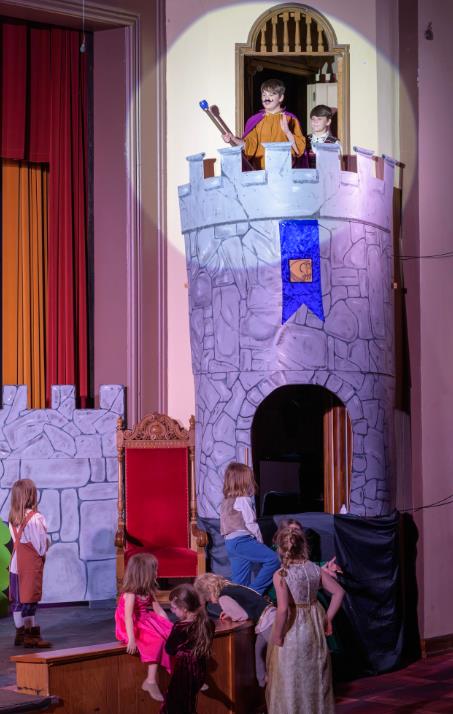
Kitscoty
Elementary, AB, Canada - Superior Arts Youth Theatre, Marquette MI
The King and his Villagers
exit as the friends recover themselves and we learn that Mortimer has
been only superficially wounded and that Saint George is not hurt at
all. They have secretly conspired to throw the battle and make it
look as if Widget won. As Saint George says, “After the battle,
no one really cares who lost and who won”.
Widget’s parents are very
proud of Widget and the Grody Gobsters congratulate him. Widget and
his friends are delighted that the battle was accomplished without
bloodshed and life will go on as peaceably as it did at the beginning
of the story.
At close, the Villagers
celebrate the day’s exuberant festivities as the new friends
enjoy each other’s company and simply spend a lovely and
peaceable evening together. In the end, civilized behavior has
triumphed over unruly conflict and violence.
“As
a rule, indeed, grown-up people are fairly correct
on
matters of fact; it is in the higher gift of imagination
that
they are so sadly to seek.”
-- Kenneth Graham
Classroom
Activities
General
Preparation for 'Alice
in Wonderland'
Talk about theatre and what a
play is. What other plays have you seen? Describe them to
the class. Why do you think certain parts of those plays are
memorable to you. What do you expect this play will be
like? What is the difference between seeing a play on
television or movies and seeing actors perform it live?
Read the synopsis in the
Teachers Guide and discuss the story. You may also want to read
the book by Lewis Carroll. Can you find Wonderland on the
map? Why not? Why do you think all the characters in the
story act the way they do? Who is your favorite character and why?
Talk about how Lewis Carroll
had to use his imagination to make up all the strange things that
Alice encountered in Wonderland. Can you make up crazy
characters and animals like that? Think of animals you know
like a bird or a horse. Now give the animal special
characteristics. Is you animal selfish or wise? Handsome
or silly? Is he hungry or hot or happy or skinny? Where
does he live? What does he where and eat? What kind of
sounds does he make? Can he talk?
Name your animal. Can
you pretend to be your animal and introduce yourself to the rest of
the class? Can they guess what kind of animal you are without
telling them? If they can, they you have just become a great
actor! (This is a great exercise to later help in the role
selection process).
Roll out some plain wrapping
paper and make a group drawing of Wonderland. Show the path
Alice took and draw the characters she met along the way: White
Rabbit, Pigeons, Caterpillar, Cheshire Cat, Mad Hatter, Gardeners,
Queen of Hearts, Flamingoes, etc. You can even make the drawing
real big and use it as a backdrop for the performance!
A
Christmas Cinderella: Read the story before performance
and show!
ArtReach puts
Holiday Twist on Classic Fairy Tale
As A
Christmas Cinderella begins the Chorus sets the scene:
Long ago in a faraway land it was a cold and silent night. All
members of the cast and audience set the mood by singing "Silent
Night". Cinderella enters her lonely room after a long day
of hard work. She looks out her window and gazes at the
beautiful castle on the hill and sings of her dreams for a better
life. Cinderella climbs into bed, shivers beneath her blanket
as Chorus sings her to sleep.
But Cinderella
is not alone. She has six mouse friends who scamper in the
room. Sam, the ring-leader tells them he has heard there will
be a Christmas ball at the castle on the hill! The mice
bemoan Cinderella's plight - all work, no play and nothing to wear to
the ball. They decorate a spindly Christmas tree to cheer
her but have only meager offerings: a block of moldy cheese, a
thimble and a safety pin. They hope a song will help - the mice and
audience sing "O, Christmas Tree".
The
mice and audience sing "O, Christmas Tree"


A
Christmas Cinderella - International Academy, Bulacan, Philippines
Greta
Snaggle-Bones roars onstage demanding her special Christmas tea!
Stepsisters Bella-Bomb and Lulu-Lolly have their own outrageous
demands. They sing "Bring the tea and the cups, Cinderella"
and poor Cinderella must rush to serve them. At the castle on
the hill King Grumble-knees has a problem. He fumes that his
fool son the Prince will not get married and the King is restless for
an heir. He demands that his assistants, Snitwick and
Sez-So, gather every unmarried maiden for his Christmas ball that
very night.
Snaggle-Bones
and the Stepsisters are singing a comic version of "The Twelve
Days of Christmas" when the King's Assistants arrive with
invitations to the ball! When Mister Snitwick includes
Cinderella in the invitation her stepsisters laugh and Cinderella
tells him that she cannot go because has nothing to wear.
Scrubbing the floor, Cinderella weeps and again sings of her hopes
and dreams.
Fairy Godmother
appears in all her splendor. With the help of the audience and
the mice Fairy Godmother works her magic and soon Cinderella is
dressed in a beautiful gown. The audience helps as Fairy
Godmother turns a pumpkin into a Christmas sleigh with none other
than the Mice as Flying Reindeer! When Fairy Godmother
wonders who will drive the sleigh, who should appear but Santa
himself! It is not yet Christmas Eve so he has the night
off and would be honored to drive Cinderella to the Christmas
ball! Off they go, dashing through the snow, as Fairy Godmother
reminds them to believe in the magic and be home at the stroke of midnight.
Fairy
Godmother turns a pumpkin into a Christmas sleigh.


A
Christmas Cinderella - International Academy, Bulacan, Philippines
Christmas cheer
abounds and the Chorus decorates the stage for the Christmas Ball as
everyone sings "Deck the Halls". Miss
Hooty-Toot leads a comic band of Fancy Ladies who compete for the
Prince's attention. Irritated by his father's plan the Prince
announces that he will only marry when he falls in love! At
that moment his eyes fall on Cinderella.
When
Snaggle-Bones and the Stepsisters arrive Cinderella runs from the
hall with the Prince following close behind. He asks her to
dance and for a brief moment it seems Cinderella's dream has finally
come true. But all too soon the clock strikes twelve. Off
she flies, leaving her shoe. The dumbfounded Prince orders that
the King's Assistants find the owner, for that lady will be his wife.
The King,
Assistants, Fairy Godmother and even Santa sing a round of "A
Shoe a Slipper or a Boot" hoping for a Christmas Day
wedding. When the King's Assistants show up at the Snaggle-Bones
house each lady tries the shoe but none of them can squeeze into
it. At last, Cinderella is asked to try and her foot glides
into the lovely slipper. The Prince appears and sings,
"Suddenly I have found my true love." and asks her to marry
him. As the everyone sings "Joy to the World"
Cinderella and the Prince are wed.
Everyone
is invited to the wedding party, even the Chorus!



A
Christmas Cinderella - International Academy, Bulacan, Philippines
Everyone is
invited to the wedding party, even the Chorus! There is cheese
for the Mice and cookies are served to everyone including the
audience! Prince Charming dances with each girl who played
Cinderella while everyone cheers, "hip, hip,
hooray"! Santa makes a return appearance, asking
Fairy Godmother to dance. All cast members waltz the stage and
even the audience joins in. At last, Fairy Godmother waves her
magic wand and the Christmas fairy tale is at an end. Santa
calls out: "Merry Christmas, everyone! Ho, ho, ho!"
"Christmas,
my child, is love in action."
Dale Evans
Glossary
for ArtReach's
The Legend of Sleepy Hollow
Words found in
Washington Irving's Classic Halloween Story
Abundance:
Having a great or plentiful amount of something.
Actuate: To
put into motion or action; activate.
Anecdotes: A
short account of an event or incident, especially those of an
interesting or amusing nature.
Arrogance:
Overbearing pride.
Washington
Irving's Classic Halloween Novel for Kids


The
Legend of Sleepy Hollow - Shawnee Playhouse, Shawnee on
Delaware, PA
Atmosphere:
The dominant mood or emotional tone of any given place.
Behooved:
To be necessary or proper for, as for moral or ethical considerations.
Burrs:
A rough or irregular protuberance on any object, as on a tree.
Cherish: To
hold or treat as dear.
Conquest: The
winning of favor, affection, and/or love.
Dame: The
mistress of a household.
Dimension: measurement
in length, width, and thickness.
Foreboding:
A strong inner feeling about the future and what is to come.
"Specter:
A ghost; some object of terror or dread."
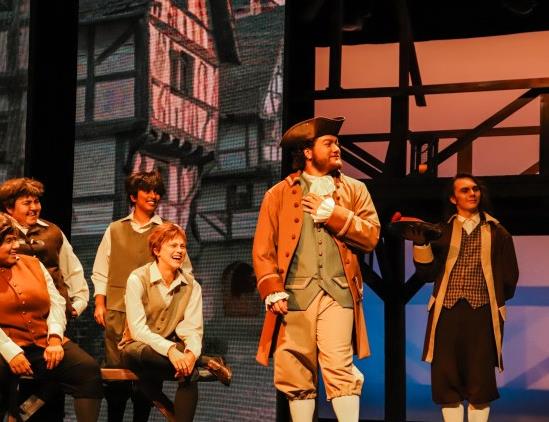

The
Legend of Sleepy Hollow - Chaffey College,
Rancho Cucamonga CA
Frolic:
Playful behavior or action; a prank.
Garnish: To
adorn or show off something ornamental.
Gaunt: Extremely
thin and bony.
Invigorate:
To fill with life and energy.
Lank:
Lean; gaunt; think. Oddly long and slender.
Lull: To
soothe or quiet.
Margin:
A border or edge. o Maxim: A principle or rule of conduct.
Mettle:
Courage and fortitude: A man of mettle.
Murmur: A
mumbled noise; a low, continuous sound; i.e., the wind.
Persevere: To
persist in anything, despite how difficult it may be.
Words
for Students, Classroom Activities


The
Legend of Sleepy Hollow - Shawnee Playhouse, Shawnee on
Delaware, PA
Pious: Relating
to religious devotion.
Pommel: The
protuberant part at the front and top of a saddle.
Potent: Powerful,
persuasive, capable.
Psalmody:
The practice of setting psalms to music.
Rapturous: Full
of or feeling extreme joy or delight.
Resplendent:
Shining brilliantly; gleaming.
Specter: A
ghost; some object of terror or dread.
Squall: A
sudden disturbance or commotion.
Trouper: A
loyal, dependable worker or participant in a job or other undertaking.
Vocation:
A job, business, profession, or a calling.
Woeful:
Full of woe; wretched; unhappy.
Thanks to: Middle Tennessee
South University, MTSU Theatre and Dance, Murfreesboro
Theatre
Games for the Classroom, ArtReach's Plays and Aladdin
Fun
Games for Elementary / Primary School Students
Fruit
Bowl (Anyone Who) Game
Class
in a circle, each child sits on a chair.
Teacher
is in the middle and explains the rules of the game.
Students
think of four things (e.g. anyone who had breakfast, anyone who
likes rap music, anyone who has a watch on, anyone who watches a
particular TV program).
When
the person (student or teacher) in the middle calls out something
you have on, have done, have seen etc., you must leave your chair and
move to another one, BUT YOU MUST NOT SIT ON A CHAIR ON EITHER SIDE
OF THE CHAIR YOU ARE PRESENTLY SITTING ON.
The
person left without a chair (the teacher is participating) becomes
the person in the middle, calling out the next criteria for moving.
The person in the middle must speak quickly and clearly.
VARIATIONS:
Students crawl, moonwalk, walk backwards (start with hands on
chairs), run, twist, skip, jump to chairs.
Magician's
Power Game
The
teacher takes on the role of the almighty powerful Magician who
holds in his/her hands the most potent power of the universe (the
Magician's hands and arms begin to shake with the awesome power and
he/she begins to hum, slowly making it louder and louder).
The
Magician's Power Game is Great for Aladdin!

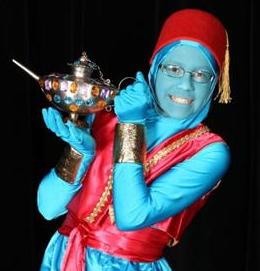

Young Aladdin
Cast, Solano Youth Theatre, Vacaville, CA
Meanwhile
the students who have been seated in a circle begin to hum also.
The
Magician explains hat he/she is going to send the power to other
magicians, but warns that those magicians seated either side of the
one holding the POWER will be shrivelled if they don't protect
themselves by raising the hand and placing it on the cheek nearest to
the person holding the POWER.
The
POWER is passed by throwing it with great force to another whilst
calling out their name
Noises
accompany the passing of the power, such as room ro shhooom.
Every
time someone is shrivelled, he/she leaves the circle.
The
winners are the last two magicians.
Trust
Run Game
Students
are in pairs.
Students
line up like a race, one partner behind the other, facing the finish
line which the teacher has marked out.
The
person behind closes his/her eyes and holds onto the hands of the
person in front.
The
teacher says "Go!" and the students race off. Once they
reach the line they swap places and race back. The most difficult
thing is to keep your eyes closed.
Fun
Activities & Ideas for A Christmas Wizard of Oz
Taking a Step
Closer to ArtReach's
A Christmas Wizard of Oz
Science:
Study cyclones, tornadoes,
blizzards etc. You may want to make your own - When the cyclone hits,
Dorothy and her house travel in the storm. You can make your own
version of a cyclone with two soda bottles, some water, a little
glitter and some duct tape. Fill one of the bottles with water and a
small amount of glitter. Tape the two bottles securely together at
the openings. Flip the full bottle to the top position and swirl them
so that the water forms a whirlpool or cyclone as it flows into the
other bottle. You may also want to get out the encyclopedia (or
library books) to learn about cyclones and weather in general. Learn
about rust. What causes rust? What can be done to prevent it?
"Is
That Santa's Reindeer in the Sky?"


Stuffed Lion and Toy Friends,
The Rhodes School, Houston TX
Geography:
Get out an encyclopedia about
Kansas (or library books). Learn about the climate, the weather and
the people of Kansas. You may also wish to make a map of Kansas. Talk
with your child about the words North, South, West and East. Label
four walls of a room with these words. This would be a great time to
teach your child how to use a compass. As you drive around town, talk
about the directions that you are traveling.
Health:
Learn about the heart and the
brain. Talk about the importance of each organ. Can we live without
either of them?
Creative
Writing: Have your child write a
story with themselves as the main character. In the story, have them
go to a strange land through a strange mode of travel and describe
all of the unusual people and the weird things they do while
there. Write a biographical sketch of at least three of
the characters in the book, "Wizard of Oz." Compare
and contrast two or more characters in the book. You may take this a
little further and do the compare/contrast exercise with the same
character, comparing the character as they appear in the book and as
they appear in the movie. Compare/contrast the book and the
Warner Brothers movie staring Judy Garland. My preference would be to
watch the movie AFTER reading the book, but this is up to you.
Math:
Figure
out how long after the story was written that the movie was
released. How many numbers you can find while reading the book?
Drama:
Have your child create a play
based on the book. Create costumes for characters in the story,
by drawing or sewing. Recite portions of the book, using correct
pronunciation, diction, voice inflection, etc. Create scenery
for your play.
World
Peace Activity for A
Thousand Cranes
Social
Studies/Humanities Classroom Activities
(From First
Stage Theatre Study Guide for A
Thousand Cranes:
https://www.firststage.org/media/pdf/CRANES_EG.pdf
Taken from:
https://worldpeace.org.au/world_at_peacePBS.asp )
1. Discuss with students what
rights should be "universal" and apply to people in all nations?
a. Begin by asking students
about the basic rights of children. "Kids everywhere
deserve..." might be a good way to start.
b. To prompt discussion, you
may want to visit the online bulletin board at the PBS "Not For
Ourselves Alone" Web site, where children submitted ideas for a
Kid's Bill of Rights. How important are these ideas? Do they apply to
kids every where? https://pbskids.org/stantonanthony/bill_of_rights.html
Advanced
Discussion - Children's Cry for World Peace


Professional Production, A
Thousand Cranes, by Gemini Collective, Angle Park, SA, Australia
(Adelaide Fringe Festival
Award 2018) Sadako's Story
2. See what international
organizations like the United Nations and UNICEF have to say about
this subject. (You may want to provide a brief introduction to the
two organizations to help students contextualize this information.)
a. Visit the UN's Human Rights
in Action interactive exhibit. There, students may access a
multimedia display built around the UN's Declaration of Human Rights.
(Note: in addition to "plain language" versions of each
article in the Declaration, this exhibit offers activity ideas built
around each article, so this may be expanded into a longer curricular
unit if you wish.) https://www0.un.org/cyberschoolbus/humanrights/index.asp
b. UNICEF's Convention on the
Rights of the Child site offers useful information that you may
paraphrase for younger children. https://www.unicef.org/crc/
3. Call to the class's
attention those statements related to safety, security, and world peace.
a. How important do these
ideas seem in the UN and UNICEF declarations? How often were they
mentioned in class discussion?
b. What do students think--is
life in a peaceful neighborhood a "right" that we should
try to ensure for every person?
4. Ask students to imagine
what a world at peace might be like. To help them imagine this, have
them visit the United Nations "Pictures of Peace" exhibit.
There, students will see drawings by other kids from around the world
and a collaborative poem created by children from 38 countries in
1997. https://www.un.org/cyberschoolbus/gallery/peace/index.asp
5. Use online photography
galleries (or have students create their own artwork) as part of an
original multimedia composition about world peace.
a. Each student (or groups of
students) should write a poem or short essay about the world at peace
and choose art work that complements their writings.
b. An online photography
gallery you might visit is the United Nations Staff Photography
Gallery https://www0.un.org/ cyberschoolbus/gallery/staffphoto/thumbs.asp
6. Finally, discuss why people
commit acts of violence. What might make individuals, groups, or
nations commit such violent acts? To have a World At Peace, how can
we prevent conflict--at home, at school, in our communities, and
around the world? Brainstorm ideas to share with families and local officials.
7. As an extension, you may
want to explore the United Nations "Preventing Conflict"
curriculum, which includes international progress reports, case
studies, activities, and recommended resources. https://www.un.org/cyberschoolbus/briefing/conflicts/index.htm
Kirigami
for Classroom Activities - Tie-in to ArtReach's
A Thousand Cranes
Fun for
Teachers and Students
Many
schools learn
to craft origami for productions of A
Thousand Cranes. Introduce your kids to its sister craft
for even more fun.
Kirigami
is a variation of origami that includes cutting of the
paper, rather than solely folding the paper as is the case with
origami, but typically does not use glue. Kirigami comes from
the Japanese words "kiru" (to cut) and "kami"
(paper). It is similar to origami because some folding is involved,
but different because the primary method of creating a design is the
skillful cutting of the paper. In the United States, the term
kirigami was introduced to paper crafters by Florence Temko in 1962.
The practice was described in detail in her book Kirigami, the
Creative Art of Papercutting.
Kirigami
Tips: Symmetry is a very important part of
kirigami. When the paper is folded before it is cut, the resulting
design is the same on both sides. Simple kirigami projects may
consist of four-fold symmetry created by folding the paper in half
horizontally, then folding it in half vertically. At the other end of
the spectrum, 12-fold symmetry can be created by folding the paper in
half, then folding it into thirds, and then folding it in half again.
Kirigami
is a
great craft project for students.



Kirigami projects by Herberger
Young Scholars Academy ASU, AZ, A
Thousand Cranes production
Most
kirigami patterns have solid lines to indicate where
to cut and shaded areas to show what portion of the paper will be
removed when you are done. Dashed lines normally indicate mountain
folds or valley folds.
Kirigami
can technically be done with any type of paper,
although the thinner paper is a must for projects that involve lots
of folding. For pop-up cards, several crafters recommend using
watercolor paper because the subtle texture adds interest to the design.
For
some people, a craft knife is easier to use than
scissors when working on a kirigami project. Use a knife with a sharp
blade and invest in a self-healing mat to avoid damaging your work surface.
Kirigami
for Children: Learning how to use scissors correctly
helps develop a child's fine motor skills. Completing simple kirigami
projects is a good way for kids to practice cutting. Scissor Craft
has several printable kirigami projects for young children. Making
paper doll chains or paper snowflakes is also a form of kirigami.
Check out PaperSnowflakes.com for a selection of unique snowflake
cutting patterns.
Kirigami
Projects: One very popular example of kirigami is the
pop-up greeting card. By artfully folding and cutting the paper
before gluing it to a colored background, you can make an image such
as a teddy bear or a bouquet of flowers appear to pop-up from the
page when the card is opened.
What
happened to Amelia Earhart?
Classroom
Discussion for ArtReach's play, Amelia
Earhart
On July 2nd, 1937 Amilia
Earhart and her navigator Fred Noonan were close to completing the
last leg of her daring around-the-world flight. They were supposed to
land on a tiny island in the Pacific Ocean with the help of a Coast
Guard ship named the Itasca. Tragically, communication was lost
with Earhart's aircraft and it never made it to Howland Island.
A massive search by the US
Government began for the wreckage, but it was never found. 80 years
later, it remains one of the greatest mysteries of all time: what
really happened to Amelia and Fred on that fateful day?
"It
remains one of the greatest mysteries of all time."
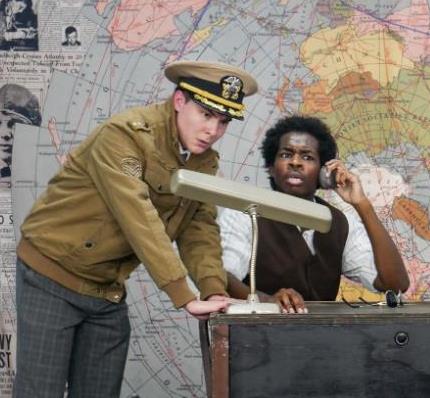
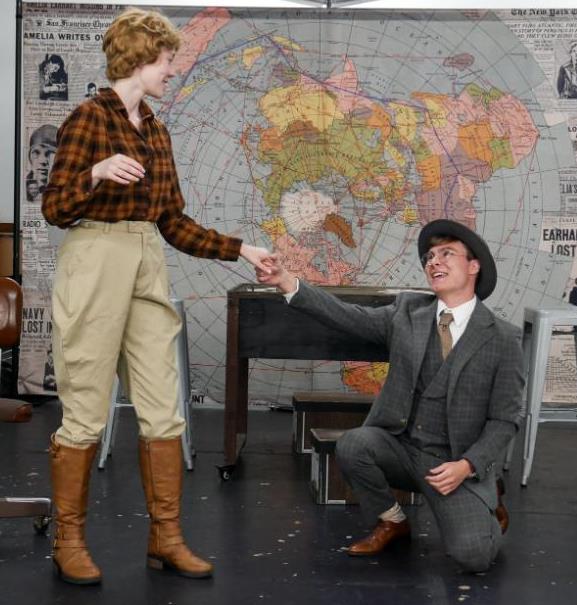
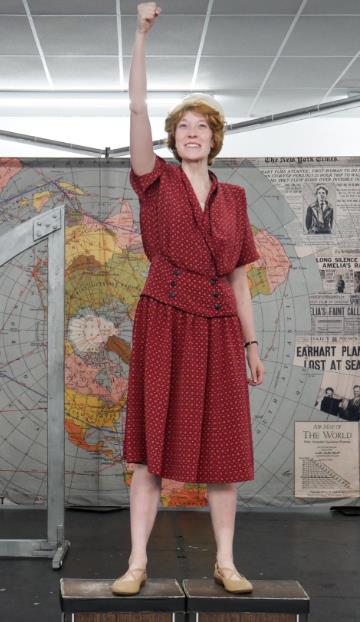
ArtReach's Amelia
Earhart - The Rev Theatre, Auburn NY
There are three prevailing
theories of what might have happened. The first is that the plane
simply ran out of gas and plummeted into the ocean. However, the
search for her plane covered some 250,000 square miles. Additionally,
in 2002 and 2006, two extensive searches of the sea floor using the
latest technology failed to turn up any sign of the plane.
Another theory is that they
landed north of Howland on the Island of Marshall and were captured
by the Japanese, possibly believing that they were spies.
The final theory is that they
landed on Nikumaroro Island when they couldn't find Howland Island.
Nikumaroro is 350 nautical miles southwest of Howland, so it is
plausible that they could have managed to land there instead.
"There
are three theories of what might have happened."
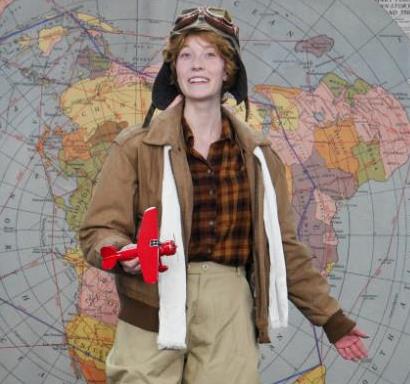

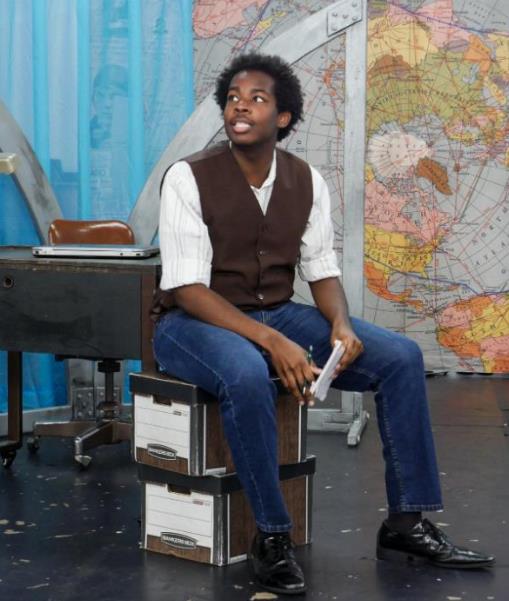
ArtReach's Amelia
Earhart - The Rev Theatre, Auburn NY
Earhart's final transmission
indicates that they were flying on a northwest to southwest
navigational line. If Noonan missed Howland, they would have kept
flying on that line to find it: northwest would have been open ocean
for thousands of miles, to the southwest would have been Nikumaroro.
Perhaps they survived as
castaways for a time on that tiny speck of an island. This would
support reports from people who claimed they received radio
transmissions from her for three nights after the crash, as well as
artifacts made out of aircraft metal that were found on the
uninhabited island.